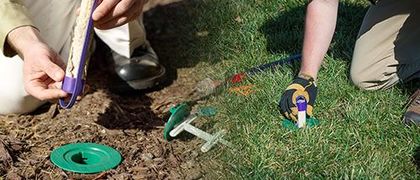What do brown dog ticks look like?
- Size: 1/4 in.
- Color: Reddish-brown
- Body Structure: Oval, flattened body, mouthparts visible from above, eight legs

Characteristics of brown dog ticks
Female adults when fully gorged with host blood may produce up to 4,000 eggs, laying them in secluded cracks and crevices. The female coats the eggs in a secretion to keep them from drying out, and then dies after completing this process, which may take 7-14 days. When the eggs hatch, the larva go in search of food, gorging themselves on a host until molting, upon which they enter the nymph stage. Here again, nymphs will seek a new host, gorging themselves on blood until molting and emerging as an adult. In indoor/enclosed environments, young ticks will gorge on the same animal instead of finding new hosts. Furthermore, the brown dog tick is unique in that it can complete the entire life cycle indoors.
When are brown dog ticks most active?
Where are brown dog ticks found?
Outdoors, brown dog ticks are often found residing on tall grasses and other vegetation, where they wait to attach themselves to a passing mammalian host. Because their preference is to feed on dogs, they're likely to be found in areas where pets are active as well.
Indoors, brown dog ticks are often found on pet bedding, kennels, and other areas where pets reside. They'll also lay eggs in cracks and crevices inside homes including baseboards, window frames, and door frames.
On pets, these biting pests are frequently detected between the toes and on the ears. Immature ticks may attach along the pet's back.
What do brown dog ticks eat?
As is the case with deer ticks and other ticks, brown dog ticks need blood meals in order to survive. Though they feed on animals, such rabbits or deer, they prefer a canine host. On occasion, they may also be found on humans.
Are brown dog ticks dangerous?
Brown dog ticks should be considered a medically important pest, capable of transmitting disease, including Rocky Mountain Spotted Fever. This species does not spread Lyme disease.
Infected brown dog ticks may also transmit canine-related diseases, such as ehrlichiosis and babesiosis.
Why do I have an brown dog tick infestation?
If you've discovered brown dog ticks in your home, there's a good chance they came in on a pet. Unlike fleas, ticks do not jump and instead crawl up tall grasses and other plants in order to drop onto a potential host when it passes by.
Your property might be at risk for ticks if there's plenty of tall grasses, trees, shrubs, shady areas, and other conditions that allow these pests to thrive.
How do I get rid of brown dog ticks?
If you're worried about ticks on your property, contact Miller Pest & Termite today to find out how our pest control specialists can help you eliminate these biting, disease-spreading pests!
How can I prevent a brown dog tick problem?
To prevent brown dog ticks from infesting your home and property and to protect yourself from tick bites, we recommend:
- Speaking with your vet about a tick preventative for your pets
- Checking pets and their sleeping areas for ticks regularly
- Mowing your lawn regularly
- Clearing away tall grass and ground cover
- Installing a crushed rock/gravel barrier around areas where your family or pets spending time, including outdoor dog kennel, play sets, and patios
- Spraying your clothes and shoes with a pest repellent containing DEET


Get Help Now!














